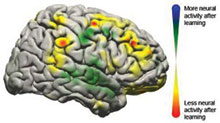University of Washington (UW), Seattle, researchers have demonstrated that when humans use brain-computer interface (BCI) technology, the brain behaves much as it does when completing simple motor skills such as kicking a ball, typing, or waving a hand. They said that learning to control a robotic arm or a prosthetic limb with a BCI could become second nature for people with paralysis.
While research has demonstrated success in using BCI in monkeys and humans, this is the first study that clearly maps the neurological signals throughout the brain. The study results were published online June 10 in the Proceedings of the National Academy of Sciences.

This image shows the changes that took place in the brain for all patients participating in the study using a BCI. Changes in activity were distributed widely throughout the brain.
Image courtesy of Jeremiah Wander, University of Washington.
“We now have a larger-scale view of what’s happening in the brain of a subject as he or she is learning a task,” said Rajesh Rao, PhD, a UW associate professor of computer science and engineering, and a senior researcher involved in the study. “There’s a lot of engagement of the brain’s cognitive resources at the very beginning, but as you get better at the task, those resources aren’t needed anymore and the brain is freed up.”
The seven study participants were asked to move a cursor on a computer screen by using only their thoughts. Electrodes on their brains picked up the signals directing the cursor to move, sending them to an amplifier, and then to a laptop to be analyzed. Within 40 milliseconds, the computer calculated the intentions transmitted through the signal and updated the movement of the cursor on the screen.
Researchers found that when patients started the task, a lot of brain activity was centered in the prefrontal cortex, an area associated with learning a new skill. But after as little as ten minutes, frontal brain activity lessened, and the brain signals transitioned to patterns similar to those seen during more automatic actions.
“Now we have a brain marker that shows a patient has actually learned a task,” said study co-author Jeffrey Ojemann, a UW professor of neurological surgery. “Once the signal has turned off, you can assume the person has learned it.”
“This is one push as to how we can improve the devices and make them more useful to people,” said bioengineering doctoral candidate and study co-author, Jeremiah Wander. “If we have an understanding of how someone learns to use these devices, we can build them to respond accordingly.”
The study was conducted concurrently with an epilepsy study in which the participants were hospitalized and monitored to identify in which part of the brain epileptic seizures originate. Because the electrodes were placed directly on the surface of the brain for the epilepsy study, researchers could record the BCI brain signals at higher frequencies and with less interference than measurements from the scalp. A future wireless device could be built to remain inside a person’s head for a longer time to be able to control computer cursors or robotic limbs at home.
Editor’s note: This story was adapted from materials provided by the University of Washington.




